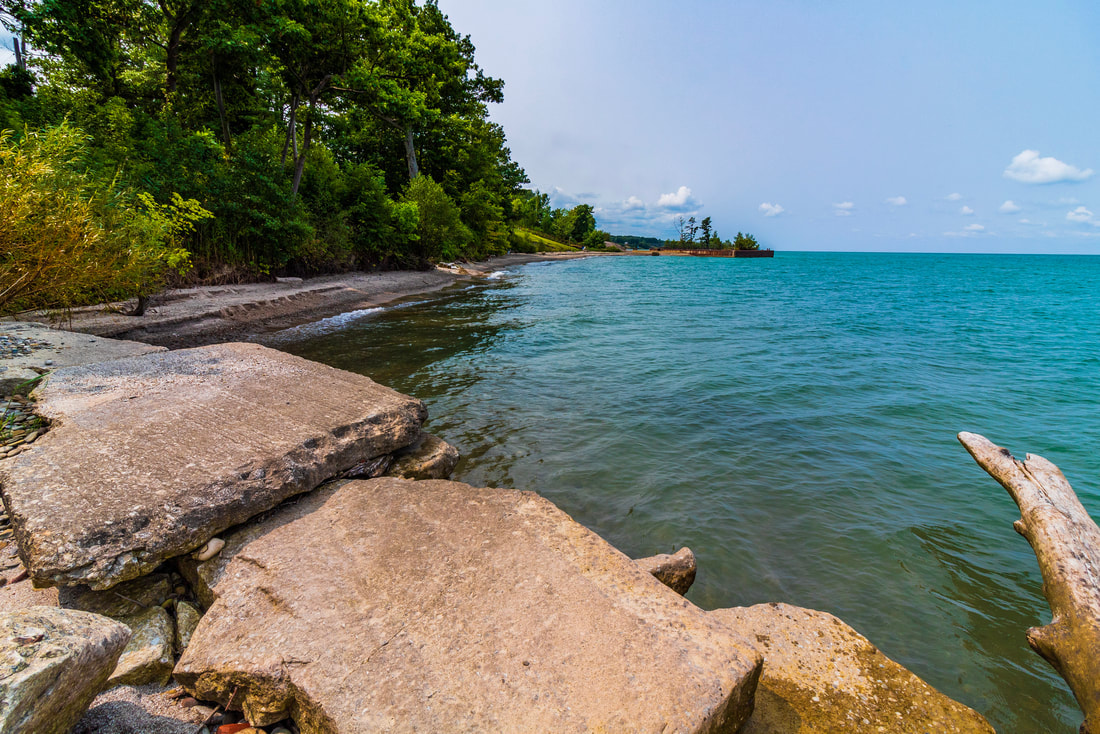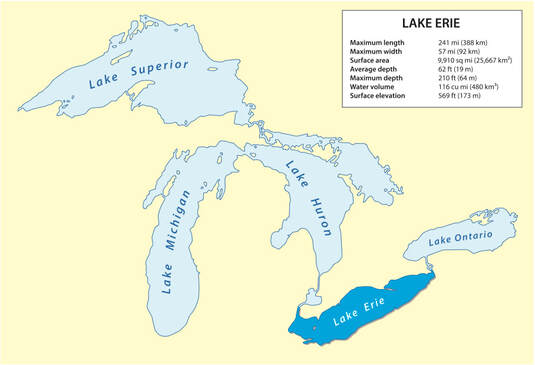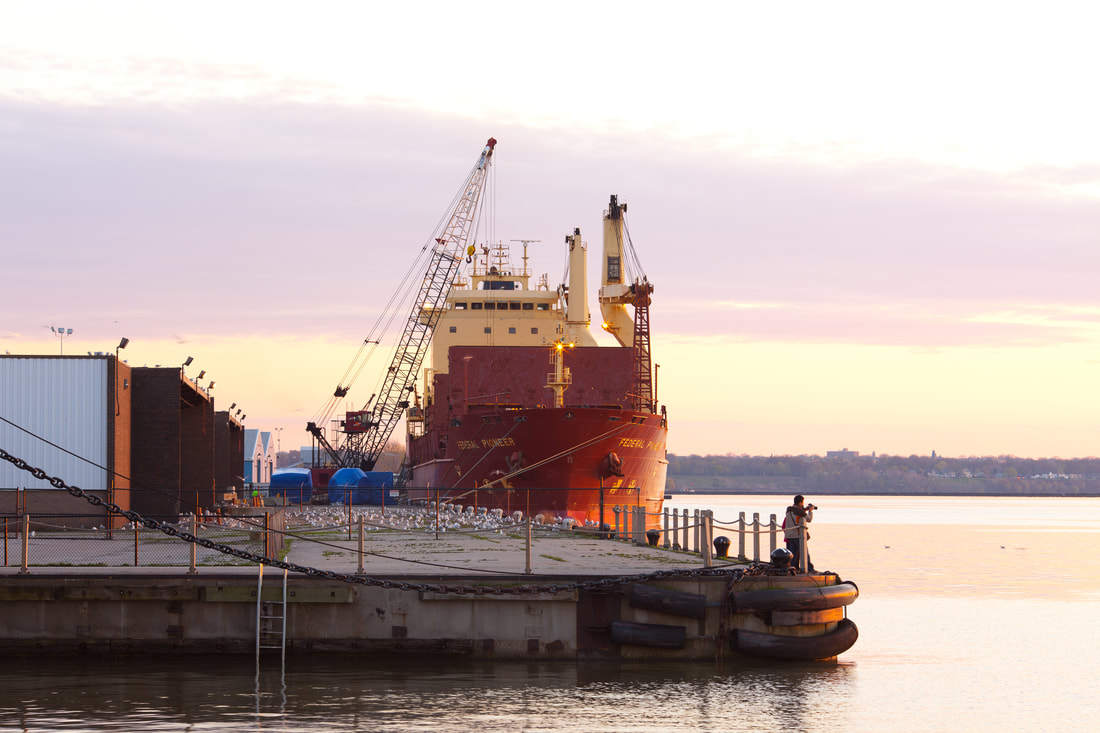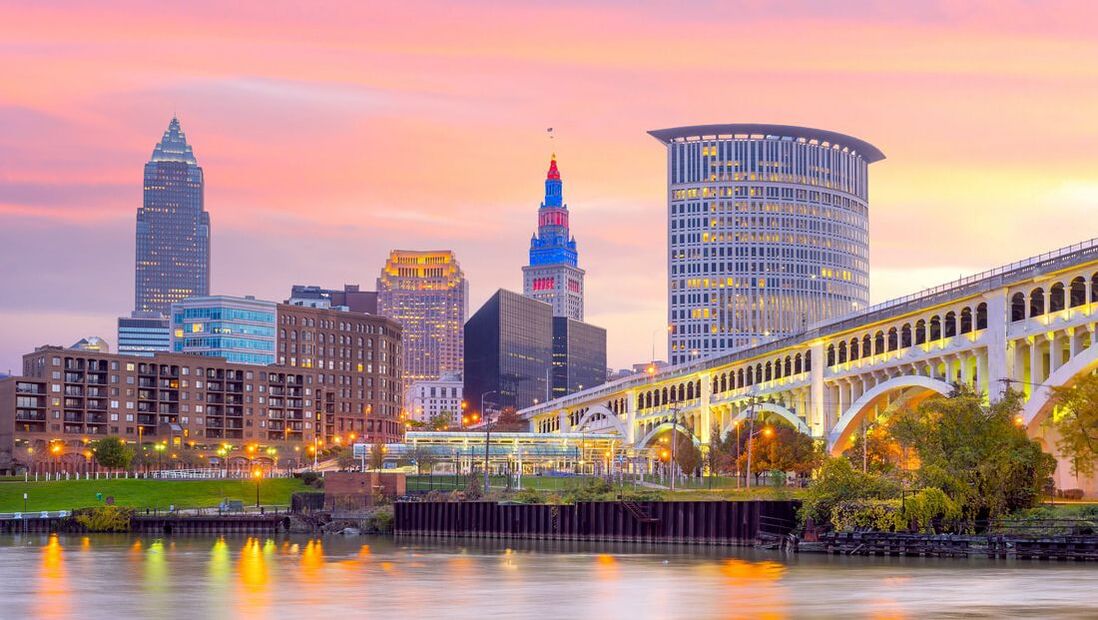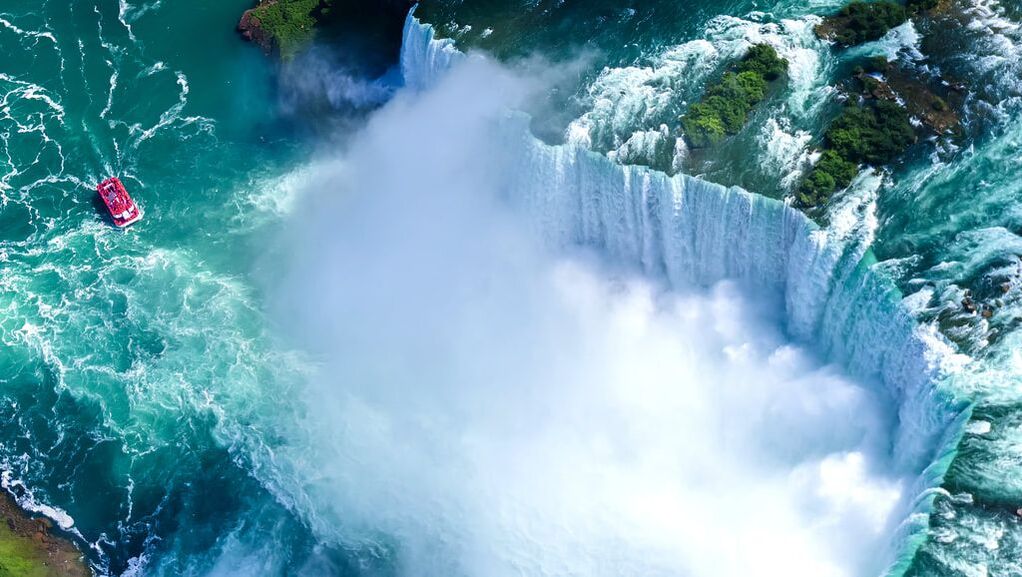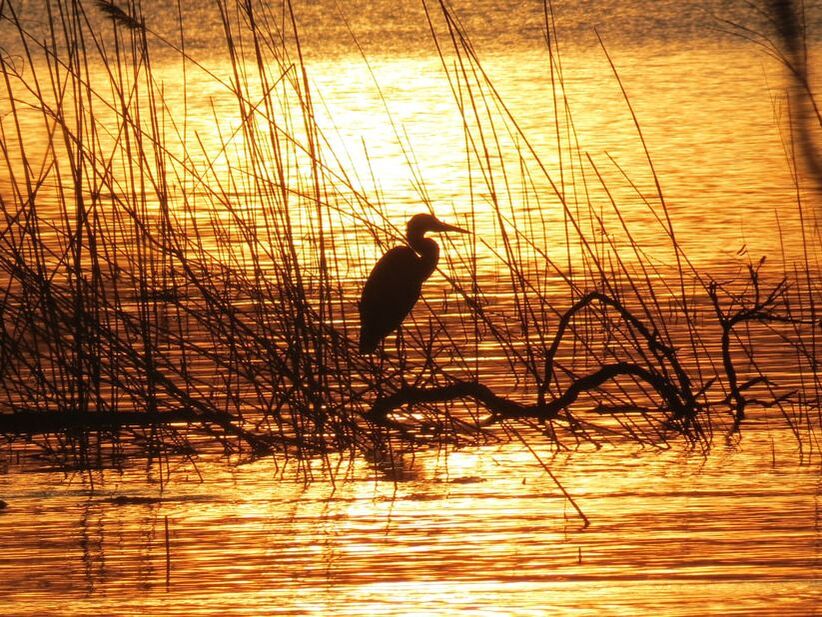|
When you choose a Lake Erie cruise, you'll have the chance to visit one of the most exciting bodies of water in North America. Offering its voyagers incredible natural beauty and more, Lake Erie also features some of the most famous destinations on the Great Lakes, lending access to the likes of Niagara Falls and Cleveland, Ohio. A favorite among Great Lakes cruises, the lake is traveled by all of our cruise lines. Experience Lake Erie in the best way possible, with fantastic comforts, immersive excursions, and fantastic ports of call.
A Brief History of Lake ErieLake Erie is well-known for its breathtaking lighting displays, but this lake and its beautiful scenery weren't made in a day. Lake Erie’s history goes back to the end of the ice age. What used to be ice-sheet-covered territory turned into basins that later filled in with water as the ice melted. The ice sheet that covered what’s now Lake Erie was thin in comparison to the rest of sheets that covered the other Great Lakes. This thin ice sheet lacked erosion power which resulted in a shallow basin.
When it first began, Lake Erie was formed from the prehistoric Lake Warren around 13,000 years ago. Lake Warren was much larger in depth and shoreline distance than Erie, leaving behind dry lake soil that couldn’t support much aside from a few trees. This land would later be used native tribes, housing an extensive network of trails that would later lead to highways like US Route 20 and US Route 30. Other parts of Lake Warren's remaining soil left sand dunes, which can still be found in Northwestern Ohio today.
Lake Erie was named after the Native American tribe Erie, which is short for Erielhonan (means long tail). The Erie tribe lived along the southern shore of the lake, while the Attawandaron tribe lived along the northern shore. In 1651, both tribes were conquered by the Iroquois Confederacy which then used the land as hunting ground. Lake Erie was the last Great Lake explored by the Europeans since the Iroquois who inhabited that area didn’t allow explorers to pass through. In 1809 British authorities developed the Talbot Trail and recruited non-american settlers to live in the area. That didn’t last long, in 1813 Americans led by the naval commander Oliver Hazard Perry captured and defeated the British fleet during the Battle of Lake Erie. This ensured American control over the lake.
About Lake ErieLake Erie is the fourth largest freshwater lake from the Great Lakes, it’s surface area reaches 9,910 sq miles. Lake Erie is also the shallowest and warmest of the five lakes, reaching 64 meters at its deepest point and averaging a temperature of 52.4 degrees Fahrenheit (11.3 degrees Celsius). Its depth and temperature cause Lake Erie to hold the shortest water residence time among the five Great Lakes, averaging only 2.6 years of water residency. Lake Erie is located in the international boundary of the United States and Canada. It borders the states of Michigan, Ohio, Pennsylvania, New York, and Ontario.
As part of the Great Lakes, Lake Erie helps move water across 3,200 kilometers throughout the course of its flow. This water flow generates an important amount of hydroelectric power to both the United States and Canada. Water flows from Lake Superior through the St. Mary’s River, all the way to Lake Huron. Then, this water flows through the Strait of Mackinac and makes its way to Lake Michigan. Most of the water then comes back to Lake Huron to travel through the St. Clair River and the Detroit River, and finally get to Lake Erie. Lake Erie then directs the water current through the Niagara River, and it makes a drastic drop creating the iconic Horseshoe Falls to finally reach Lake Ontario. This is its last stop in the magnificent freshwater lakes. Water then exits to the Atlantic Ocean through the St. Lawrence River.
Lake Erie is home to several bays and archipelagic islands that give life to the American Inland Seas. The Maumee Bay, located in Ohio, features one of the most popular bird-watching spots in the country. Another well-known bay in Lake Erie is the Sandusky Bay, also located in Ohio. The Thomas A. Edison Memorial Bridge connects Erie and Ottawa counties over this important body of water.
There are around 30 islands that reside within Lake Erie’s surface. South Bass Island, also known as Put-in-Bay, is the most touristic and developed of them all. The North Bass Island (also called Isle St. George) and Middle Bass Island attract some tourism as well. They offer tourists a couple of state parks and recreational sites.
|
Great Lakes LibraryTo explore more of the Great Lakes, from their histories to their myths and mysteries, visit our hand-curated Great Lakes Cruise Library.
<
>
Lake Erie
|
Elevation |
569 ft |
Surface Area |
9,910 mi² |
Drainage Area |
30,140 mi² |
Volume of Water |
116 mi³ |
Avg Depth |
62 ft |
Max Depth |
210 ft |
Length (N-S) |
57 mi |
Length (E-W) |
241 mi |
Length of Shoreline |
871 mi |
Avg Surface Temp |
52º F |
Retention Time |
2.6 years |
Avg Outflow |
265,000 ft³/s |
Read more on the "Physical Features of the Great Lakes" from the EPA .
Lake Erie
By the Numbers
Elevation |
173 m |
Surface Area |
25,700 km² |
Drainage Area |
78,000 km² |
Volume of Water |
484 km³ |
Avg Depth |
19 m |
Max Depth |
64 m |
Length (N-S) |
92 km |
Length (E-W) |
388 km |
Length of Shoreline |
1,402 km |
Avg Surface Temp |
11º C |
Retention Time |
2.6 years |
Avg Outflow |
7,504 m³/s |
Read more on the "Physical Features of the Great Lakes" from the United EPA .
Cruise Ports of Call on Lake Erie
While there are many potential stops along Lake Erie, the most popular Lake Erie ports of call are:
And, located just off Lake Erie along the Detroit River is:
- Detroit, Michigan
- Windsor, Ontario
Lake Erie's Most Famous Ports of Call
Lake Erie is home to a couple majestic ports of call for Great Lakes Cruises. The journey begins with the port of Cleveland, which features a handful of activities and entertainment for all kinds of travelers. Cruises often travel to the world-known Niagara Falls, which is the next port of call. This iconic port features breathtaking views of the Horseshoe Falls right before entering Lake Ontario. The port of Cleveland and Niagara Falls are must-see stops when you cruise the Great Lakes. Here’s a list of attractions, itineraries, and cruise lines that will help you explore and make the best out of your Lake Erie experience.
Visit Cleveland, OhioFrom arts and culture to history and outdoor activities, Cleveland, Ohio cruises are packed with a variety of sights to discover. The largest city visited by Lake Erie cruises, Cleveland has lots to explore. One of the most popular spots in the city is the Rock and Roll Hall of Fame. This iconic site is filled with hundreds of music exhibits that cover early rock & roll influencers, performers, song writers, and producers. Make sure to plan at least a few hours, since covering all 3 floors of memorabilia and interactive exhibits takes time. Other attractions include The Cleveland Museum of Art, which features over 61,000 art pieces from all over the world. This world-class museum is known for its Asian and Egyptian art, plus several other permanent displays that bring thousands of visitors annually. This museum is one of the most visited in the world. Another must-see museum in the area is the Cleveland Museum of Natural History. This museum features collections in the fields of anthropology, archaeology, botany, geology, astronomy, zoology, biology, and even paleontology.
For nature-inspired travelers, The Cleveland Metroparks Zoo and the Cleveland Botanical Garden are a must. The 183-acre zoo displays wildlife from multiple regions such as Australia, Africa, and Asia. Meanwhile, the botanical garden has magic on its own. It is home to hundreds of plant species and it’s a local favorite too
Or, food lovers may want to stop by the historic West Side Market to grab a bite. This market features delicacies from all over the world within its walls, and was even named 2010's "Best Food Lover's Market" by Food Network Magazine
|
Visit Niagara FallsThis iconic city is a Great Lakes treasure. Located in the Canada, Niagara Falls, Ontario cruises invite visitors to see first-hand Lake Erie’s drastic drop into Lake Ontario, where 3 world-renowned waterfalls -- Horseshoe Falls, American Falls, and Bridal Veil Falls -- are formed. The Lake Erie Niagara Falls are a nature-immersive experience for travelers. Some of the city’s top destinations include the Skylon Tower, which overlooks Niagara Falls, and the Journey Behind the Falls, which delivers up-close views of the falls from subterranean caverns below. On this Canadian side of Niagara, you'll find the most massive and recognized of the 3 waterfalls, Horseshoe Falls. Surrounding the falls are a multitude of fun attractions, like the adventurous Whirlpool Aero Car, which takes tourists in cable car rides across the Niagara River. Or you can visit the beautiful Queen Victoria Park, one of the city's many parks, and its most popular. Animal and nature lovers will also likely enjoy Bird Kingdom -- the world's largest free-flying indoor aviary -- and MarineLand -- with its dolphins, orcas, and amusement park rides. The two local attractions showcase and educate visitors about all kinds of wildlife from all over the world.
Just nearby off of Lake Ontario, travelers will find the town of Niagara-on-the-Lake, a quaint destination that invites travelers to explore another set of attractions, including its Butterfly Conservatory and numerous wineries. Cruises visiting the falls most often anchor in Port Colborne, Ontario before embarking on a quick 31 minute drive, where the distance from Lake Erie to Niagara Falls is a mere 32.2 km (20 mi).
On the US side -- Niagara Falls, NY, you'll find American Falls, Bridal Veil Falls, the Cave of the Winds, and the sprawling Niagara Falls State Park.
|
Cruise Lines with Lake Erie Itineraries
More Interesting Info for Your Lake Erie Cruise
The Ecosystems of Lake Erie
Lake Erie and the rest of the Great Lakes contain 20% of the world’s total freshwater, and over 3,500 species. For instance, Lake Erie is home to over 250 bird species that migrate annually to the area. They reside mostly around Sandusky Bay and Maumee Bay, making these spots optimal for bird-watching all year long. Lake Erie is also home to hundreds of fish species such as Walleye and Yellow Perch, plus several invasive species.
|
Over the years, climate change has reduced water levels, and pollutants, population, and the introduction of invasive species have all negatively affected Lake Erie’s natural environment. As part of the Great Lakes, Lake Erie is crucial for natural water filtration, flood control, and nutrient cycling in North America. The U.S.A. and Canada are aware of the value this natural resource possesses, and the danger in which Lake Erie could potentially fall into. Therefore, they created the Great Lakes Compact. This act protects the Great Lakes international waters (overseen by the Great Lakes Commission), to prevent water diversion with a set of standards that individuals, businesses, and all levels of government must follow. The Great Lakes Compact has been a huge help to the area's conservation, preventing habitat loss in the Great Lakes for not just wildlife, but for us -- humans -- as well.
|
Lake Erie's Economy
Around 1850, fishing became one of Lake Erie’s main economic activities. It rose as settlers established fisheries, which increased maritime traffic. Commercial fishing boomed in 1901, and a new harbor was built to accommodate more shipments. Later in the 20th century, both commercial and sport fishing began to decline.
The 5 states that border Lake Erie had built industries and communities around the lake, and water pollution became a major issue. The pollutants and sewer waste that was thrown into the river streams in the area ended up in the lake. Additionally, Lake Erie helped provide drinking water to nearly 40 million people a day, plus 212 billion liters a day for industries and farms. This also exploited the lake’s resources causing a negative impact on the environment. Preserving the lake’s native fish species became a challenge. However, fishing is still the top economic activity of the region. Tourism and agriculture are also crucial to the area.
Today, countless efforts exist to prevent pollution, leaving fishing still the top economic activity on Lake Erie. The most common kinds of fish All around the massive lake, you'll also find destinations reliant on agriculture and tourism as well. The Lake Erie region is a major producer of corn and soybeans,
Secondary economic activities in the area include grape growing and wineries. These reside along the coast of New York and Pennsylvania. There used to be a vast amount of wineries within Lake Erie’s Archipelagic Islands as well. Most of those wineries closed with the exception of the ones in Pelee Island. Today, the Lake Erie islands’ economy is sustained by tourism. Because of this, countless Lake Erie cruise ships visit the destinations lining these island shores with guests seeking the most from their Great Lake cruise. Unlike the other Great Lakes, Lake Erie doesn’t have many wind turbines due to opposition from the residents. They believe the wind turbines would be intrusive to the ecosystem and ultimately spoil the views.
more destinations: Lake erie nature and wildlife
- Cleveland Metroparks Zoo, Cleveland, OH
- Cleveland Botanical Garden, Cleveland, OH
- Greater Cleveland Aquarium, Cleveland, OH
- Rocky River Reservation, Cleveland, OH
- Cuyahoga River, Cleveland, OH
- Nature Center at Shaker Lakes, Cleveland, OH
- Rockefeller Park & Greenhouse, Cleveland, OH
- Rocky River Nature Center, Cleveland, OH
- Niagara Falls, Niagara Falls, NY
- Horseshoe Falls, Niagara Falls, NY
- Journey Behind the Falls, Niagara Falls, NY
- American Falls, Niagara Falls, NY
- Cave of the Winds, Niagara Falls, NY
- Bridal Veil Falls, Niagara Falls, NY
- Niagara Skywheel, Niagara Falls, NY
- Butterfly Conservatory, Niagara Falls, NY
- Fallsview Indoor Waterpark, Niagara Falls, NY
- Bird Kingdom, Niagara Falls, NY
- MarineLand, Niagara Falls, NY
- Niagara Whirlpool, Niagara Falls, NY
- Niagara Observation Tower, Niagara Falls, NY
- Terrapin Point, Niagara Falls, NY
more destinations: lake erie museums and historic sites
- Rock & Roll Hall of Fame, Cleveland, OH
- The Cleveland Museum of Art, Cleveland, OH
- Cleveland Museum of Natural History, Cleveland, OH
- Museum of Contemporary Art Cleveland, Cleveland, OH
- A Christmas Story House, Cleveland, OH
- Great Lakes Science Center, Cleveland, OH
- The Children’s Museum of Cleveland, Cleveland, OH
- Cleveland History Center, Cleveland, OH
- USS COD, Cleveland, OH
- Steamship William G. Mather Museum, Cleveland, OH
- International Women’s Air & Space Museum, Cleveland, OH
- Soldiers’ and Sailors’ Monument, Cleveland, OH
- James A. Garfield Monument, Cleveland, OH
- Crawford Auto Aviation Museum, Cleveland, OH
- Hope Memorial Bridge, Cleveland, OH
- Fountain of Eternal Life (Memorial Fountain), Cleveland, OH
- Rainbow International Bridge, Niagara Falls, NY
- Ripley’s Believe It or Not, Niagara Falls, NY
more destinations: lake erie islands
- Ballast Island
- Big Chicken Island
- Bird Island
- Buckeye Island
- Chick Island
- East Sister Island
- Gard Island
- Gibraltar Island
- Green Island
- Gull Island
- Hen Island
- Indian Island
- Johnson’s Island
- Kafralu Island
- Kelley's Island
- Little Chicken Island
- Lost Ballast Island
- Middle Island
- Middle Sister Island
- Mohawk Island
- Mouse Island
- North Harbour Island
- Pelee Island
- Presque Island
- Rattlesnake Island
- Ryerson’s Island
- Second Island
- Snow Island
- Starve Island
- Sugar Island
- Turtle Island
- West Sister Island
more destinations: lake erie rivers and beaches
- Euclid Beach Park, Cleveland, OH
- Whiskey Island, Cleveland, OH
- Edgewater Park Beach, Cleveland, OH
- Rocky River, Cleveland, OH
- Mill Creek Falls, Cleveland, OH
- Great Falls of Tinkers Creek, Cleveland, OH
- Goat Island, Niagara Falls, NY
- White Water Walk, Niagara Falls, NY
Explore Lake Erie Cruise Destinations
Updated 10-31-22 BB
